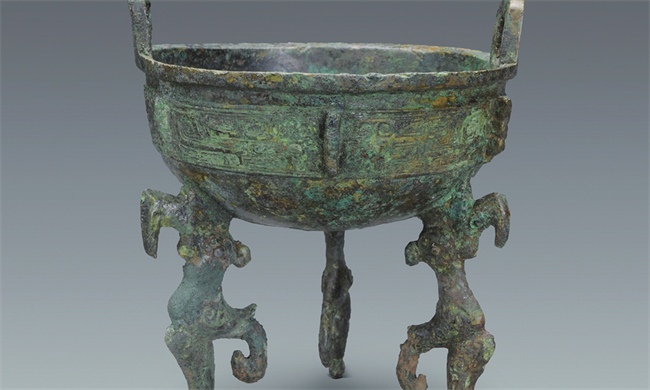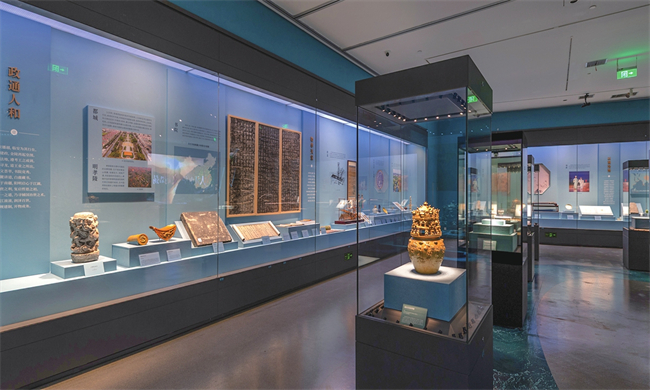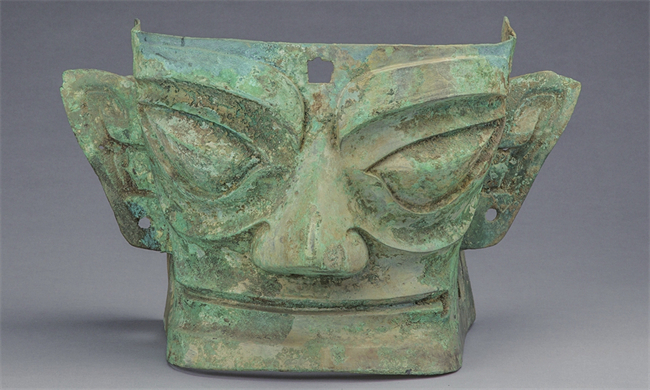
A bronze bird-footed ritual vessel

The Yangtze River themed exhibition at the Changsha Museum. Photo: Courtesy of NCHA
Light ripples beneath visitors' feet as Tang Dynasty(618-907) poem "The endless [Yangtze] river rolls its waves hour after hour" by Du Fu melts into digital waves across the gallery floor.
Here, at the Changsha Museum in Central China's Hunan Province, "The Ever-Flowing: Exhibition of the Yangtze River and the Chinese Civilization," the centerpiece of China's 2025 Cultural and Natural Heritage Day, unfolds like the mighty waterway itself, carrying audiences through different chapters that mirror the profound cultural legacy of Yangtze, China's longest river system.
Showcasing over 200 precious cultural relics, the exhibition stands as the largest, most sophisticated display since the museum's relocation.
Fang Fang, one of the curators and a deputy researcher from the museum, told the Global Times that the exhibition is divided into three main chapters, with each further split into three or four sub-sections, forming 11 units that symbolize the 11 provinces and regions where the Yangtze River's main stream flows.
"Artifacts become narrators here," explains Fang, guiding visitors through three sweeping chapters that mirror the Yangtze River's zigzagging journey from source to sea.
The first part explores the river's role in the origin of Chinese civilization. The second part focuses on the Yangtze River's contributions to the development of Chinese civilization through artifacts. The third part, finally, examines the Yangtze River's significance in political, economic, cultural, and diplomatic aspects of Chinese civilization.
According to Fang, the exhibition integrates diverse cultural regions along the Yangtze River, from the ethnic Qiang-Tibetan and Bashu cultures, to the cultures of the state of Jing and Chu, as well as the state of Wu and Yue dating back to the Spring and Autumn and Warring States Periods (770 BC-221 BC), under the one same theme.
The over 200 pieces of cultural relics from the well-known Sanxingdui ruins site, Hemudu site, Liangzhu site and more have showcased the rich legacy of the Yangtze River.
"By using the Yangtze River as a stage and related cultural relics as key characters, this exhibition will spotlight the Yangtze River's pivotal role in shaping the five distinctive features of Chinese civilization, which are consistency, originality, uniformity, inclusivity, and a peaceful nature," said Jin Ruiguo, an official from the National Cultural Heritage Administration (NCHA), in a press release on June 6.

A bronze mask unearthed at the Sanxingdui Ruins
Starry legacy
"Other regions show fragments, while the Yangtze River presents the full epic," Wang Wei, chief archaeologist of tracing origins of Chinese civilization, told the Global Times.
The Yangtze River has ample archaeological evidence to support a million-year human history, a 10,000-year cultural history, and a 5,000-year civilization history, he noted, giving an example of the discoveries like the third skull fossil of "Yunxian Man" in Central China's Hubei Province, dating back about a million years, as evidence of the Yangtze River's ancient human history.
Early agricultural and pottery remains from sites like Yuchanyan and Pengtoushan demonstrate its 10,000-year cultural heritage, and the Qujialing culture, a late Neolithic culture, from over 5,000 years ago marked a regional civilization milestone.
Media sources reported that the Yuchanyan site revealed the earliest artificially cultivated rice about 10,000 years ago, and Pengtoushan, a key Neolithic culture, is believed to be one of the earliest paddy-field remains found so far in the middle reaches of the Yangtze River.
Both Yangtze River and Yellow River cultures, having shared a long history, developed prehistoric agriculture, simultaneously, which led to the development of handicrafts, urbanization, and social evolution in China. While they have unique characteristics, they influenced and intertwined with each other, forming the core of Chinese civilization, Wang noted, adding that with its rich sub-cultures like Chu, Bashu, and Wu-Yue, the Yangtze River culture has vast research potential.
Unity through diversity
The construction of the Yangtze River National Cultural Park links these scattered cultural treasures. Since the construction of the Yangtze River National Cultural Park was officially launched in late 2021, remarkable progress has been made.
The project, which involves 13 provinces, autonomous regions, and municipalities, aims to integrate cultural heritage protection, tourism development, and ecological conservation along the Yangtze River.
In Southwest China's Sichuan Province and Chongqing Municipality, they have jointly sorted out the rich cultural heritage along the Yangtze River in their regions and selected 144 representative cultural symbols.
Through a special survey of cultural relic resources, they have verified 91,000 immovable cultural relics and 1.791 million movable cultural relics, including 326 national key cultural relic protection units, and 1.308 million precious cultural relics.
Hubei Province in Central China has built a "one-axis, two-corridor, three-area, four-zone" spatial pattern for the protection and utilization of Yangtze River culture.
The construction of projects such as the Quyuan Cultural Park and the Water Culture Tourism Area of the Middle Route of the South-to-North Water Diversion Project has started smoothly.
A number of national archaeological site parks, including the Qujialing national archaeological site park, have been completed and opened to the public. The construction of the museum in the Chu culture is set to be completed in 2027, per the Xinhua News Agency.
Jiangsu Province in East China has registered and included 1.024 million cultural and tourism resource monomers along the Yangtze River section in the province, and organized the selection of "100 Scenes of the Yangtze River," and 20 "Water Charm Jiangsu" Yangtze River cultural and tourism boutique routes.
"Rivers are chronicles of civilization, embodying the very essence of a nation and its people. The construction of the Yangtze River National Cultural Park stands as a paragon of Chinese civilization, elevating cultural confidence to new heights," Wang said.
Source: Global Times








